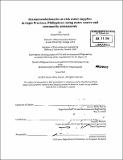| dc.contributor.advisor | Susan E. Murcott. | en_US |
| dc.contributor.author | Patrick, Jessica Molly | en_US |
| dc.contributor.other | Massachusetts Institute of Technology. Dept. of Civil and Environmental Engineering. | en_US |
| dc.coverage.spatial | a-ph--- | en_US |
| dc.date.accessioned | 2011-01-26T14:22:54Z | |
| dc.date.available | 2011-01-26T14:22:54Z | |
| dc.date.copyright | 2010 | en_US |
| dc.date.issued | 2010 | en_US |
| dc.identifier.uri | http://hdl.handle.net/1721.1/60778 | |
| dc.description | Thesis (M. Eng.)--Massachusetts Institute of Technology, Dept. of Civil and Environmental Engineering, 2010. | en_US |
| dc.description | Cataloged from PDF version of thesis. | en_US |
| dc.description | Includes bibliographical references (p. 83-86). | en_US |
| dc.description.abstract | The following thesis is part of a larger project which began in response to a request by the Provincial Health Office (PHO) in Capiz Province, Philippines for expert advice to support its drinking water quality testing program. Civil and Environmental Engineering Department Senior Lecturer, Susan Murcott, recommended specific state-of-the-art test methods for quantification of E.coli in drinking water as well as the involvement of a Massachusetts Institute of Technology (MIT) Master of Engineering (MEng) team in collaboration with the test program. The results of this microbiological water quality testing program, along with water source and community assessments completed during January 2010, have been used to make recommendations for potential infrastructure upgrades and improvements to drinking water systems in the region. In water samples collected from December 2009-March 2010, 65% were found to be contaminated with E.coli. While the sampling program was designed to sample a higher proportion of sources which were suspected to have contamination, the significant number of samples with E.coli contamination illustrates the importance for residents and for officials at the national level to focus on the provision of microbiologically safe drinking water. Water source assessments made use of WHO Sanitary Survey templates, and they showed that many hazards are present around public water sources, and that it is highly likely that some of these- specifically septic tanks and animal waste- are contributing to poor microbiological water quality. Key-informant interviews and focus-group discussions conducted during the community assessments showed that water management systems are lacking, awareness regarding factors affecting drinking water safety are lacking, and that equal access to sources are lacking (upland areas are poorly served). Both short and long term recommendations have been made and are the focus of this thesis. Education, monitoring and training will be key components; as well as household water treatment and safe storage for existing supplies. Longer term plans need to include strategies for aligning and developing systems within the province to existing national level regulations, the development of effective management systems both at the municipal and provincial level, and finally on securing the necessary funding to implement improved programs and services. | en_US |
| dc.description.statementofresponsibility | by Jessica Molly Patrick. | en_US |
| dc.format.extent | 123 p. | en_US |
| dc.language.iso | eng | en_US |
| dc.publisher | Massachusetts Institute of Technology | en_US |
| dc.rights | M.I.T. theses are protected by
copyright. They may be viewed from this source for any purpose, but
reproduction or distribution in any format is prohibited without written
permission. See provided URL for inquiries about permission. | en_US |
| dc.rights.uri | http://dspace.mit.edu/handle/1721.1/7582 | en_US |
| dc.subject | Civil and Environmental Engineering. | en_US |
| dc.title | Recommendations for at-risk water supplies in Capiz Province, Philippines : using water source and community assessments | en_US |
| dc.type | Thesis | en_US |
| dc.description.degree | M.Eng. | en_US |
| dc.contributor.department | Massachusetts Institute of Technology. Department of Civil and Environmental Engineering | |
| dc.identifier.oclc | 693585688 | en_US |
